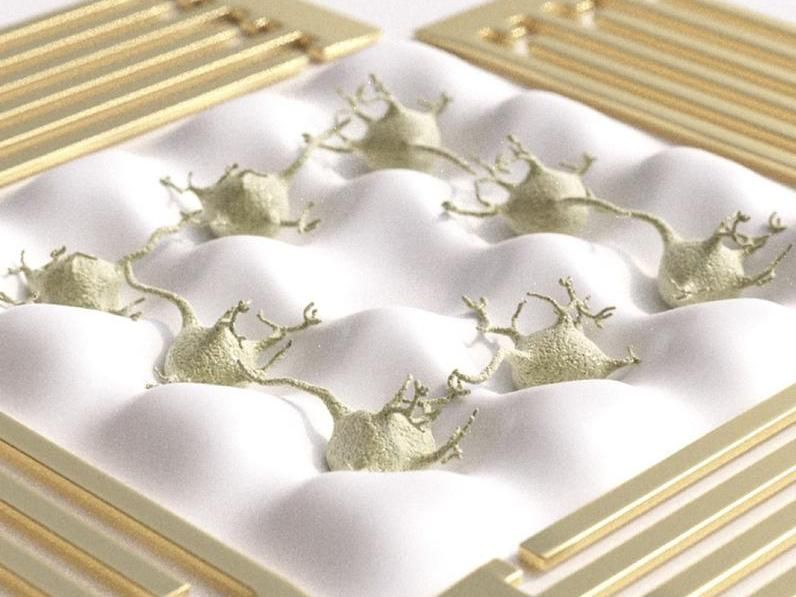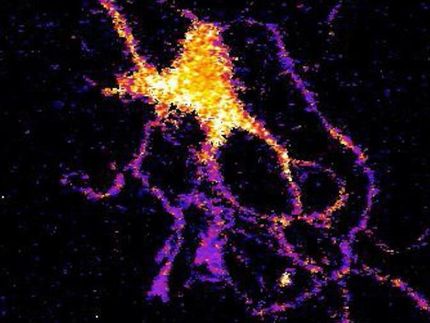Surface acoustic waves orchestrate neuronal networks
Advertisement
Biophysicists from Augsburg and Santa Barbara report on the first successful outcome in the targeted dynamic positioning of nerve cells on a chip. The proven Augsburg surface acoustic wave technology now opens up new ways of understanding and influencing neuronal networks.

Neuronal cells on a biochip. The applied acoustic wave field influences not only the position of the cell but also the growth of neuronal outgrowths which connect these cells.
Christoph Hohmann, NIM
The junior research group led by biophysicist Dr. Christoph Westerhausen at the Chair of Experimental Physics I at the University of Augsburg, in cooperation with colleagues from the University of California at Santa Barbara, has succeeded for the first time, using surface acoustic waves (sound waves induced by high-frequency signals which propagate on the surface of chips), in the targeted positioning of live neuronal cells on a biochip at periodic intervals and even in influencing the growth of the neuronal cells. "This is an important step towards so-called brain-on-a-chip systems and could fundamentally contribute to understanding the processes in the human brain," says Professor Dr. Achim Wixforth.
Wixforth and his chair's biophysics group have a worldwide reputation as leading specialists in the interaction between cells and so-called surface acoustic waves on a single chip. The principle of the technology developed by Wixforth is that, as a result of a "nano-earthquake" caused by the application of an appropriate high-frequency signal to on-chip electrodes, the propagation of these sound waves on the crystal surface of the chip can be controlled.
Dynamically adjustable, controlled cell positioning
Westerhausen and his Augsburg colleague Manuel Brugger now show that, based on this nanotechnology, they have succeeded in developing, together with their partners in Santa Barbara, a novel, dynamically tunable method of controlled and targeted cell positioning, including the subsequent attachment and culture of the cells on a microfluidic chip. By acoustically capturing small polymer spheres and positioning them at variable intervals, the nanophysicists demonstrate the full range of possibilities offered by this new method. The researchers in Augsburg and their colleagues from Santa Barbara could furthermore establish the long-term biocompatibility of treatments based on the growth of various cell types — such as bone cancer cells, kidney cells or neurons — which are purposefully manipulated on the chip.
Convincing correlation of the alignment of cell-to-cell connections and the acoustic field
“The icing on the cake and probably the most important result of our work is the successful stimulation of very delicate primary neuronal cells and the outgrowths that connect these cells. The alignment of these cell-to-cell connections convincingly correlates with the particular acoustic field applied and the resulting potential landscape, and allows us to speak here of the first form of a very small neuronal network produced on a chip by means of acoustic waves", Westerhausen states.
New promising perspectives in the exploration of neuronal networks
The possibilities of using static approaches — e.g. by an appropriate patterning of the chip surface — to produce or manipulate neuronal networks, have proven to be limited. “With our dynamic method” explains Brugger, “we can overcome this limitation and offer basic research into biophysics — such as the correlation between structure, signal propagation and function of neuronal networks —new and far-reaching perspectives for the long-term”.
Medical applications are quite conceivable
Medical applications - such as the targeted manipulation of cell growth in spinal injuries - are still a long way off, but quite conceivable. Westerhausen: "As far as the development of our new method and, above all, its potential applications are concerned, we are bubbling with ideas. By proving that with our “nano-earthquake”, or surface acoustic wave, technology, the targeted and precise arrangement of delicate neurons is feasible and that it can purposefully influence the links between neurons, we have laid an important foundation for further promising basic research and new application perspectives in this field”.



























































